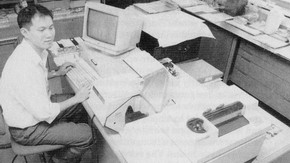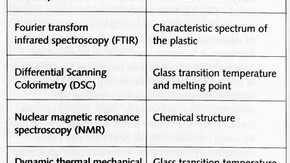Conservation Journal
January 1993 Issue 06
A survey of plastic objects at The Victoria & Albert Museum
Background
Until recently, the task of conserving plastic objects in the collections of the Victoria and Albert Museum has been the responsibility of the conservation section most closely allied with the collection in which the objects are kept. This arrangement has worked reasonably well. Objects have been treated in any one of nine conservation sections according to their character. Plastic chairs, for example, have been the responsibility of Furniture Conservation, while plastic raincoats have gone to Textile Conservation.
As the number of plastic objects in the collections has continued to rise, conservators have been confronted with a range of problems associated with their care and treatment. The acknowledged importance of these objects led to the appointment in February 1992 of the Museum's first conservator specialising entirely in plastics, based in the Ceramics Conservation Section. Over the past twelve months the conservator has created a standard method for surveying the plastics collections as the first stage of a strategy for the identification and conservation of vulnerable objects.
'Plastic' is a general expression used to describe a very wide range of natural and synthetic organic materials as well as some inorganic materials such as silicone rubber. Such materials may be divided into two categories, thermoplastics and thermosets. Thermoplastics retain their ability to soften and be remoulded, whilst thermosets harden permanently in the form in which they have been manufactured. The raw materials used for the manufacture of plastics are derived mainly from petroleum and coal. Typical polymeric materials include natural rubber, semi-synthetics such as cellulose nitrate and truly synthetic polymers such as the polyolefins, polyvinyls, and polyester resins.
The earliest examples of 'plastic' objects are made from naturally occurring substances such as amber, horn, bone, gutta percha, shellac and tortoise shell. Like their synthetic counterparts these materials have a molecular structure based on long chains of carbon atoms. Examples of these objects include buttons, snuff boxes, brooches, combs, jewellery and picture frames.
In the nineteenth century, semi-synthetic plastics such as vulcanised natural rubber and cellulose nitrate were introduced. Ebonite was used in manufacture of telephones, jewellery and fountain pens. Cellulose nitrate, commonly referred to by its trade name Celluloid, was adopted for making film, billiard balls and dolls. Table tennis balls are still made from it. The natural ivory colour of cellulose nitrate has also been exploited in the form of imitation ivory, horn and tortoise shell artefacts.
The early twentieth century saw the arrival of some of the common synthetic plastics we know today. The first on the market was probably phenol formaldehyde, better known as Bakelite. It was used mainly for furniture and electrical goods. Since the mid twentieth century, the number of synthetic polymers has increased rapidly, as has the range of products in which they are employed.
Many of the early plastics were primarily of interest to designers and manufacturers as a cheap alternative to precious or rare counterparts, for example, gemstones, ivory and wood. Costume jewellery, statues and radios were often cast from different types of formaldehyde resins. The relatively low cost of the raw materials, however, has meant that plastic objects have traditionally been less valued than articles made of the 'real thing' and have often been considered as disposable. This attitude is changing rapidly. Plastic objects have now become highly collectable, and are sold for considerable sums alongside other antiques and works of art. It has to be acknowledged that one day plastics will be as important as any other material in a collection of art and design.
Degradation of plastics
Although there is much current research in the field of plastics in general, very little is directed specifically towards the conservation of plastic objects made in the past. Studies are usually concerned with the prevention or modification of polymer deterioration processes with new products in mind. Where deterioration has occurred, plastic objects are usually considered to have reached the end of their useful life, and ready for replacement. For the conservator this means very little can be done to reverse the degradation process, either chemically or physically. The only option is to reduce the rate at which it is happening.
Although the exact mechanisms are still uncertain, degradation can be initiated in several ways and begins from the moment when the polymer is fast synthesised. The history of the raw materials and products are both important in determining the stability of the object. None of the polymerisation techniques used commercially can produce a 100% 'pure' polymer. As a result, polymer chains with sites of imperfection are produced. These will often provide points for the initiation of degradation. The presence of very small quantities (ppm) of impurities such as aluminium and nickel may also be important. Such metals are used as catalysts in the production of, for example, polyethylene and polypropylene, but may also subsequently catalyse the degradation of these polymers.
The storage conditions experienced by the raw polymer and fmal product are also significant. For example, stabilised polyethylene and polypropylene powder will degrade relatively quickly even at ambient temperatures. The manufacturing process is another potential source of heat-induced degradation. Polymers must usually be heated to high temperatures - considerably higher than their melting point - before they can be processed. Although thermal stabilisers (typically a hindered phenol like butylated hydroxytoluene) are added to polymers during processing, some thermal degradation still takes place. Mechanical degradation due to chain-scission also occurs as a consequence of the high shear which the polymer melts are subjected to during injection moulding and extrusion moulding. These processes are often followed by rapid quenching, resulting in the formation of internal stresses. The final stages of production usually involve assembly of parts or printing, all of which can cause further deterioration. Hence, even before the fmal product reaches the shelf, degradation may have already been initiated and degradation products, such as peroxides may already be present. During the service life of the object it may then be exposed to various factors which may accelerate the degradation process. Exposure to heat, light, atmospheric pollutants and uv radiation, for example, all result in further deterioration.
Surveying plastics collections

Fig. 2. Toy from the Krazy Kat Kollection at the Archive of Art and Design (click image for larger version)
Because of the variety of materials involved and the variety of applications for each material, the term 'plastic' does not carry any more specific information than, for example the word 'metal'. The conservator is confronted with many variations in the type of plastic (including composites, copolymers and blends). Each has its own chemical and physical properties and the situation is further complicated by the presence of additives such as dyes and stabilisers used in the manufacture of plastic objects. This makes identification difficult, which in turn creates problems for the conservator. Only when the composition of an object is known can conservation work be carried out safely and a recommendation for storage and display conditions be made. For example, acetone can be use for treating polypropylene but would cause severe crazing to polystyrene.
In order to gain a realistic picture of the extent of the V&A's plastic collection and the condition of the objects, the first responsibilty of the conservator has been to initiate a survey. This is being accompanied, as far as possible, by chemical characterisation of the objects through identification of the main components, giving priority to the objects most urgently in need of treatment.
Types of damage
The deterioration of a plastic object can be described in two main ways. On the one hand, there may be 'damage' at a molecular level, for example as a consequence of chain scission or cross-linking. On the other, there may be observable changes at a macroscopic level - physical damage, discolouration and so on . Because of the restriction on the amount of material that may be removed for chemical analysis, it is more convenient to make an assessment of condition based on the latter. It is important when examining objects that signs of damage and deterioration are described in a systematic way. About twenty terms have therefore been adopted which can be used consistently to describe the most common symptoms of deterioration observed during the survey. Most of these have quite obvious meanings and do not need to be methodically defined here. Predictably, several refer to mechanical damage (crazed, cracked, chipped, broken, warped, embrittled etc.) and several to changes in appearance or the development of surface films (yellowed, discoloured, stained, bloomed etc.)
To define the extent, rather than the nature of damage, we have used a 4 point system similar to that described by Keene1 . This involves assigning an object to one of four categories according to its condition. Category 1 indicates an object in perfect condition; 2, slightly damaged but stable; 3, damaged and unstable; and 4, extremely unstable and requiring urgent treatment.
Techniques for the identification of plastics
There are a number of techniques that can be used to identify the generic group to which a plastic sample belongs. Accuracy depends on the technique selected and generally, the more techniques that are used in the identification process, the more reliable the result. Where sampling of an object is restricted, only techniques causing minimal damage should be used for analysis. Table 1 lists some of the instrumental methods available.
Of the techniques listed in Table 1, Fourier transform infrared spectroscopy offers the most information while demanding the absolute minimum of damage to the object tested. The Conservation Department has therefore recently purchased a new instrument (Perkin-Elmer FTIR). It is hoped to provide details of the chemical analyses of samples from objects in the collections in a later article.
Results of the survey to date
To date, more than 4500 objects in the V&A collections have been identified as plastic or part plastic. The survey has so far focused on the toy collection at the Bethnal Green Museum of Childhood. Here, about 75% of the objects are construction kits - models of vehicles, ships, animals and people. Although the exact composition of the materials from which they are made has not been determined, it is highly probable that a large proportion of these toys are made of polystyrene.
Of the objects examined so far, more than half are in perfect condition. 24% are slightly damaged but stable, 13% damaged and in need of treatment and about 1% require urgent treatment. 8% of the objects are still in their original packaging and there are other materials (mainly boxes and manuals) which are considered to be part of the plastic objects.
The highest proportion of the damage is due to surface dirt/grease, abrasion and scratches. This is typical of objects which have, at one time or another, been handled. It must be stressed that a large proportion of these objects are prototypes donated by the manufacturers, which explains the high percentage in perfect condition.
Physical damage such as cracks, fractures and chips makes up about 23% of the total damage whilst 13% are suffering distinctly from 'chemical damage' For the most part, this refers to the type of deterioration shown by rubber parts such as the tyres and tracks used for model tanks and tractors. Self adhesive tape and other adhesives also account for the yellowing and staining of objects. Most of the mechanical damage can be attributed to poor handling and storage conditions, probably before the objects were acquired by the Museum.
The storage facilities at Bethnal Green Museum of Childhood are quite adequate. The low light level, stable temperature and humidity level are helping to control the rate of deterioration. The general storage conditions could be improved by avoiding overstacking. The separation of parts made of different materials in order to avoid cross contamination would also control deterioration rate; additives such as plasticisers can migrate into neighbouring parts causing objects to soften or to weld together. Another recommendation that can be made at this stage is the avoidance of the practice of coating the Museum number with varnish for plastic objects. It has been noted that a number of objects have shown signs of damage due to the solvent from the varnish. Until a more suitable alternative is found the number should be left uncoated.
When the survey at Bethnal Green is completed in January 1993, it will then be possible to get a clearer overall picture of this particular collection. The survey has so far been extended to include the 'Krazy Kat Kollection' at the Archive of Art and Design at Blythe House, which was completed in October 1992. The next stage is to examine the rest of the plastic objects in the collections at the South Kensington site and at the Theatre Museum. A complete assessment of the condition of the entire collection of plastics belonging to the Victoria and Albert Museum may not be available for some time but in the meantime we will try to keep readers regularly informed.
Reference
January 1993 Issue 06
- Editorial
- The conservation of Roger Fenton's album of Crimean photographs
- A question of principle
- A survey of plastic objects at The Victoria & Albert Museum
- Preventive conservation in practice
- Introducing the new course tutor
- Textile conservation in Russia
- Assessment RCA/V&A conservation course: science for conservators

